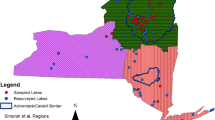Abstract
The results of three national monitoring programs in the United States (U.S.) that measure concentrations of tributyltin (TBT) are compared. Regional and site comparisons are made of changes in TBT concentrations since passage of the Organotin Antifouling Paint Control Act (OAPCA) in 1988. The monitoring programs compared are the U.S. LongTerm Monitoring Program conducted by a consortium of tributyltin manufacturers, the National Oceanic and Atmospheric Administration's National Status and Trends Mussel Watch project, and the U.S. Navy's TBT monitoring program. All of the monitoring results demonstrate declining TBT concentrations over time. These declines have occurred rapidly (within a few years) and are considerable (56%–71% decrease in TBT concentrations in water, 47%–55% decrease in sediments, and 40%–82% decrease in bivalve tissues). Mean TBT concentrations in water are generally below the current U.S. Environmental Protection Agency marine chronic water quality criterion of 10ng/L. These results indicate that the OAPCA has been effective in reducing TBT concentrations in the aquatic environment.
Similar content being viewed by others
References
U.S. Congress (1988) Organotin antifouling paint control act of 1988. H.R. 2210-3. One Hundredth Congress of United States of America, Second Session. Washington, D.C.
Beaumont AR, Budd MD (1984) High mortality of the larvae of the common mussel at low concentrations of tributyltin. Mar Pollut Bull 15:402–405
Champ MA, Bleil DF (1988) Research needs concerning organotin compounds used in antifouling paints in coastal environments. U.S. Department of Commerce, NOAA. Rockville
Waldock MJ, Thain JE (1983) Shell thickening inCrassostrea gigas: Organotin antifouling or sediment induced? Mar Pollut Bull 14:411–415
U.S. EPA (1986) Data call-in notice for data on tributyltins in paint antifoulants. EPA, Office of Pesticides Program, Washington, D.C.
Unger MA, Maclntyre WG, Greaves J et al (1986) Determination of butyltins in natural waters by flame photometric detection of hexyl derivatives with mass spectrometric detection. Chemosphere 15(4):461–470
Seligman PF, Grovhoug JG, Fransham RL et al (1990) U.S. Navy statutory monitoring of tributyltin in selected U.S. harbors annual report: 1989. Naval Ocean Systems Center Technical Report 1346, San Diego
Wade TL, Garcia-Romero B, Brooks JM (1991) Oysters as biomonitors of butyltins in the Gulf of Mexico. Mar Environ Res 32:233–141
Uhler AD, Durell GS, Steinhauer WG et al (1993) Tributyltin levels in bivalve molluses from the east and west coasts of the United States: Results from the 1988–1990 National Status and Trends Mussel Watch projec. Environ Toxicol Chem 12:139–153
U.S. EPA (1991) Ambient aquatic life water quality criteria for tributyltin. Office of Research and Development, Environmental Research Laboratories, Duluth and Narragansett
NOAA (1989) A summary of data on tissue contamination from the first three years (1986–1988) of the Mussel Watch Project: Progress report. NOAA Technical Memorandum NOS OMA 49, U.S. Department of Commerce, Rockville
Author information
Authors and Affiliations
About this article
Cite this article
Russell, D., Brancato, M.S. & Bennett, H.J. Comparison of trends in tributyltin concentrations among three monitoring programs in the United States. J Mar Sci Technol 1, 230–238 (1996). https://doi.org/10.1007/BF02390799
Received:
Accepted:
Issue Date:
DOI: https://doi.org/10.1007/BF02390799




